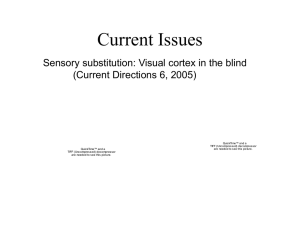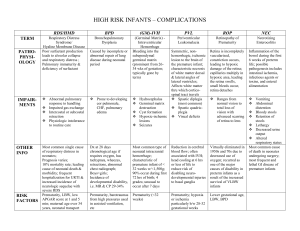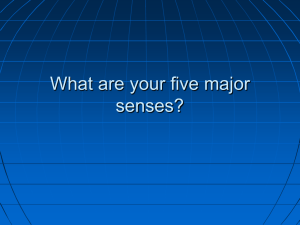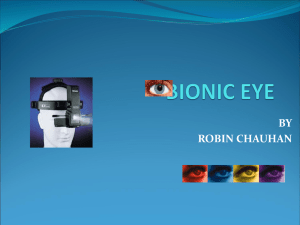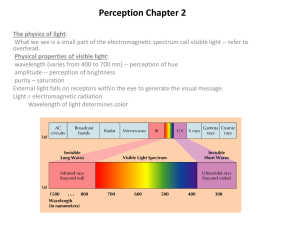Tutorial_07_08_E
advertisement
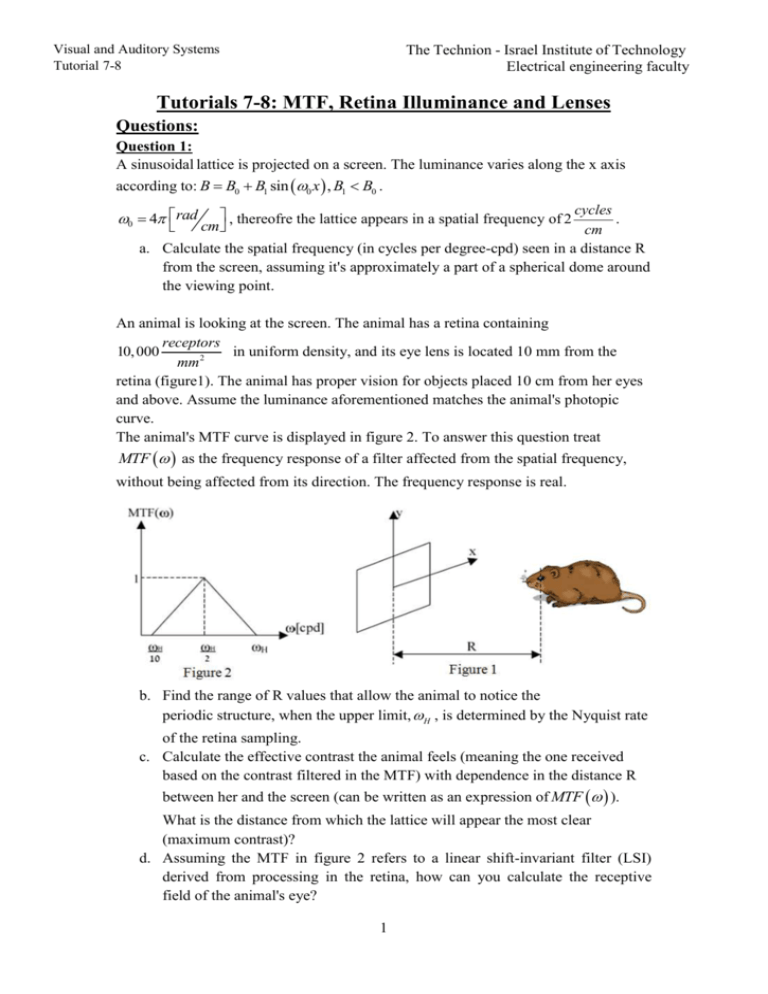
Visual and Auditory Systems Tutorial 7-8 The Technion - Israel Institute of Technology Electrical engineering faculty Tutorials 7-8: MTF, Retina Illuminance and Lenses Questions: Question 1: A sinusoidal lattice is projected on a screen. The luminance varies along the x axis according to: B B0 B1 sin 0 x , B1 B0 . cycles . cm a. Calculate the spatial frequency (in cycles per degree-cpd) seen in a distance R from the screen, assuming it's approximately a part of a spherical dome around the viewing point. 0 4 rad cm , thereofre the lattice appears in a spatial frequency of 2 An animal is looking at the screen. The animal has a retina containing receptors 10, 000 in uniform density, and its eye lens is located 10 mm from the mm 2 retina (figure1). The animal has proper vision for objects placed 10 cm from her eyes and above. Assume the luminance aforementioned matches the animal's photopic curve. The animal's MTF curve is displayed in figure 2. To answer this question treat MTF as the frequency response of a filter affected from the spatial frequency, without being affected from its direction. The frequency response is real. b. Find the range of R values that allow the animal to notice the periodic structure, when the upper limit, H , is determined by the Nyquist rate of the retina sampling. c. Calculate the effective contrast the animal feels (meaning the one received based on the contrast filtered in the MTF) with dependence in the distance R between her and the screen (can be written as an expression of MTF ). What is the distance from which the lattice will appear the most clear (maximum contrast)? d. Assuming the MTF in figure 2 refers to a linear shift-invariant filter (LSI) derived from processing in the retina, how can you calculate the receptive field of the animal's eye? 1 Visual and Auditory Systems Tutorial 7-8 The Technion - Israel Institute of Technology Electrical engineering faculty Question 2: Given the impulse response of the visual system of a certain animal is: h x, y 2 exp ax2 by 2 exp bx2 ay 2 , ab a. Calculate and sketch the animal's frequency response H u, v . b. Explain the difference between this animal's MTF curves for an experiment where the illuminance lattice is horizontal, vertical or diagonal. c. Explain how the outcome of section b will change, dependent on the constants a, b . Question 3: The receptors density of the retina in a certain animal is displayed below: The animal's distance between retina and eye lens is 10 mm , the refractive index of the vitreous (transmission medium inside the eye) is n 1 , and the internal transmission coefficient is 0.3 . a. The animal is capable of clearly identifying distant objects, starting from 10 cm . What is the focal length range of the animal's eye lens? The animal is placed in front of a screen, looking at point A: b. Gratings in varying spatial frequencies are projected on the screen. What are the maximal frequencies (in cpd) that can be noticed by the animal in points A, B, C? For the sake of this solution use a spherical dome approximation for the screen. Note the center of the animal's retina is pointing to point A in all cases. 2 Visual and Auditory Systems Tutorial 7-8 The Technion - Israel Institute of Technology Electrical engineering faculty cd c. The screen is lightened uniformly with luminance B 10 2 . m What is the animal's retina illuminance in Lux, with and without taking in to consideration the C-S phenomenon (Stiles-crawford)? The answer should be given in Troland and Eff. Troland. The relation between the pupil's diameter and the luminance is according to the human model (using the tanh formula). 2 The C-S phenomenon effect is: r exp r 10 , r mm Question 4: A person with myopia, who can see clearly up to 0.5 m , is wearing glasses with 2 D . a. What is the maximal distance to which this person can now see clearly? b. The same person accidentally put on a 2 D glasses. What are his vision limitations now and what is the maximal distance to which he can now see clearly? Question 5: An approximation of the photopic curve is given in figure 1, to be used to calculate the lumen value in this question, and an additional curve of another kind of flux, in the UV range, called uven, is given in figure 2. This question involves the human visual system, so the uven units express flux, but do not describe a light sensation, because they are not part of the visible light range. in the range A source with A 1 m 2 is producing uniform radiation of 8 mW nm 100 800 nm . The luminous emmitance is uniform and lambertian all over the source's area. a. Calculate how much lumen and uven are produced from the source and the luminances B and BUV based on the lumen and uven definitions respectively. b. The source covers the viewer's visual field fully. What will be the retina's visible light illuminance ( E ' ) according to the lumen, and the retina's UV illuminance ( EUV ' ) according to the uven definition? The pupil's diameter is identical in both cases and determined by the visible light based on the lumen. 3 Visual and Auditory Systems Tutorial 7-8 The Technion - Israel Institute of Technology Electrical engineering faculty Assume identical transmission and refraction for both visible light and UV in the medium inside the eye - n 4 , 0.5 . The C-S effect can be 3 neglected. The information on the pupil's diameter, the transmission and refraction in section b are all valid for section c as well. c. UV radiation is known to be harmful for the eye. Figure 3 describes two options providing protection for the eyes from strong radiation, visible and non-visible ("sunglasses") of the aforementioned source. 1) Which sunglasses will create a more substantial sensation of reduced light? 2) What is the retina's UV illuminance ( EUV ' ) in each of the following cases? In UV damages terms, is it preferable to not wear sunglasses at all in compare to one of the possibilities? The C-S effect can be neglected. d. Calculate the amount of Troland and Eff. Troland that arrive to the retina without sunglasses. 4 Visual and Auditory Systems Tutorial 7-8 The Technion - Israel Institute of Technology Electrical engineering faculty Solutions: Question 1: a. A view from above: The period length is x0 1 f0 1 2 cm The angular period length is: x0 1 180 90 [rad ] deg deg R 2R R 1 R cpd 0 90 0 tan 0 b. First we shall calculate the longitudinal receptors density: 10, 000 100 mm 1 x 1 mm sample distance 100 For small angles n ' (Snell's law). RR - Distance between the lens and retina. ' x 0.01 mm 180 3 103 rad 10 deg RR 1 cm Assuming ' n 1 : According to Nyquist law s 1 H 2 H (sampling frequency in the retina) 1 8.36 cpd 2 0.36 5 Visual and Auditory Systems Tutorial 7-8 The Technion - Israel Institute of Technology Electrical engineering faculty There are two limitations that need to be taken in to account in the R calculation: 1) The given vision range R 10 cm H R H 10 90 Using (2) we get 25 cm R 250 cm , which also fits limitation (1). 2) MTF: c. The contrast for a sinusoidal lattice is: B C 1 B0 Ceff C MTF B1 R MTF B0 90 C eff is maximal in the frequency where the MTF is maximal, meaning for 1 2 H , therefore: Ropt 90 H 125 cm 2 d. The retina response assuming a LSI system is R x E x * g x . The retina's impulse response: h x g x . Since the MTF is the retina's frequency response MTF F h x . Therefore: g x F 1 MTF 6 Visual and Auditory Systems Tutorial 7-8 The Technion - Israel Institute of Technology Electrical engineering faculty Question 2: a. H u, v F 2 D h x, y 2 F2D exp r 2 exp 4 F exp ax 2 by 2 H u, v 2D r ; x2 y 2 ; 2 u 2 v2 u 2 v2 exp ab 4b 4a u 2 v2 ab 2 u 2 v2 u 2 v2 exp exp 4 a 4 b 4b 4a 7 Visual and Auditory Systems Tutorial 7-8 The Technion - Israel Institute of Technology Electrical engineering faculty b. A comparison between MTF curves received for an experiment where the lattice is horizontal/vertical (continuous line) to an experiment where the lattice is diagonal (Dashed line): c. The closer the ratio a is to 1, we receive a bigger radial symmetry, and of course the b MTF for an experiment with a diagonal lattice approaches the MTF for an experiment with a horizontal/vertical lattice. In the graph presented in section the ratio is In the following graph the ratio is a 1.33 : b 8 a 3. b Visual and Auditory Systems Tutorial 7-8 The Technion - Israel Institute of Technology Electrical engineering faculty Question 3: a. For objects placed in : 1 1 1 1 1 f max 1 cm f u v 1 For a larger focal length, the eye lens won't be converging enough. For objects placed in a distance of 10 cm : 1 1 1 1 1 f u v 10 1 Therefore the focal length range is: f min 10 cm 11 0.909 cm f 1cm b. For point A: The point is right in front of the center of the retina, where the receptors density is 105 mm1 . The distance between 2 receptors is therefore 105 mm , and the angular sampling distance is: 105 0.16 104 rad 0.018 deg 10 This is the angular sampling distance outside the eye, found using the connection for small angles n . The maximal frequency, according to the Nyquist rate on the retina sampling is: H 1 1 1 1 H 27.8 cpd 2n 2 1 0.018 0.036 2 For points B, C: The calculation is done in the same way, only the receptors density is according to the point location. 0.15 180 2.9 deg 3 0.35 180 C 6.7 deg 3 B B receptors density 5 10 4 mm 2 receptors density 3 10 4 mm 2 2 105 4.47 104 rad 0.026 deg 10 3.3 105 C 5.77 104 rad 0.033 deg 10 H 1 19.2 cpd 2 1 0.026 H 1 15.2 cpd 2 1 0.033 Meaning, the sensitivity to the spatial frequency decreases as the distance from the center of the vision field rises. c. Calculation of the pupil's diameter: d 5 3tanh 0.4log10 10 3.68mm Calculation of : n 2 12 2 2 1 1 2 cm v 1 9 Visual and Auditory Systems Tutorial 7-8 The Technion - Israel Institute of Technology Electrical engineering faculty Calculation of the pupil's area: S d2 11.7 mm 2 0.117 cm 2 4 Calculation of the retina's illuminance in Lux: E BS 0.3 110 0.117 0.35Lux Calculation of the retina's illuminance in Troland: B S 10 11.7 117 Troland Calculation of the effective area: d 2 d Seff 2 r rdr 2 0 2 re r2 10 0 d dr 10 1 e 2 40 9.77 mm 2 d 3.86mm Calculation of the retina's illuminance in Eff.Troland: B Se 10 9.77 97.7 Eff. Troland Question 4: a. 1 2 f f -1 2 m We have to find the focal distance from the lens u which will result in v 1 (the distance in which the person sees clearly) 1 1 1 1 2 2 u f v u u The conclusion – now this person can see clearly to any distance! b. The eye has a f max which focuses to the retina starting from u 1 m . 2 10 2 Visual and Auditory Systems Tutorial 7-8 The Technion - Israel Institute of Technology Electrical engineering faculty 1 f max 1 1 2.2 50 f max 2.1 cm For 2 lenses in a row (glasses lens + eye lens): f f 2.1 50 f eq 1 2 2 cm f1 f 2 2.1 50 f eq Was calculated for f max of glasses lens + eye lens, and it will give us the maximal distance: 1 1 1 2 2.2 u umax 22 cm Question 5: a. f const 8 mW nm F f K d 8 103 300 100 700 100 300 100 1040 lumen 0 1 FUV f KUV d 8 103 200 700 560 uven 2 0 Since the surface is lambertian: L B L F 1040 1040 lux A 1 LUV FUV 560 uven 560 2 A 1 m B BUV cd 331 2 m 560 UV cd 178.75 2 m 1040 b. First we shall calculate the pupil's diameter: d 5 3 tanh 0.4 log B 5 3 tanh 0.4 log 331 2.71 mm 2 d S 5.73 mm 2 5.73 102 cm 2 2 2 4 n 3 0.36 cm 2 v 2.2 ' E B S 0.5 0.36 331 5.73 102 3.41lux 2 uven ' EUV BUV S 0.5 0.36 178.25 5.73 102 1.87 2 m c. (1) Fa 0.5F 520 Lumen 11 Visual and Auditory Systems Tutorial 7-8 The Technion - Israel Institute of Technology Electrical engineering faculty Fb f b K d 0 8 103 0.6 300 100 0.15 700 100 0.15 300 100 264 lumen 500 600 nm 600 700 nm 400500 nm L Fa 520 cd Ba a 162.52 2 A 1 m Bb Lb Fb 264 cd 84 2 A 1 m d a 5 3 tanh 0.4 log165.52 2.87 mm db 5 3 tanh 0.4 log 84 3.06 mm 2 d Sa a 6.47 mm 2 6.47 102 cm 2 2 Sb 7.35 102 cm 2 E Ba Sa 0.5 0.36 165.52 6.47 10 2 1.93 lux ' a Eb' Bb Sb 0.5 0.36 84 7.35 102 1.11lux Conclusion: Ea' Eb' , so in terms of visible light, glasses b are preferable! (2) FUV ,a 0.5 F 280 uven FUV ,b f b KUV d 0 8 103 1 0.5 100 700 0.6 0.5 700 100 448 uven 400 500 nm 500 600 nm F 280 UV cd BUV ,a UV ,a 89.13 2 A 1 m F 448 UV cd BUV ,b UV ,b 142 2 A 1 m ' 2 EUV 1.04 lux , a BUV , a S a 0.5 0.36 98.13 6.47 10 ' 2 EUV 1.89 lux ,b BUV ,b Sb 0.5 0.36 142.6 7.35 10 ' ' ' Conclusion: EUV , a EUV EUV ,b , meaning glasses a improve (pass more visible light and less UV) and glasses b spoil. 12 Visual and Auditory Systems Tutorial 7-8 The Technion - Israel Institute of Technology Electrical engineering faculty d. The formula for the retina illuminance: cd B 2 S mm 2 m troland BS 331 5.73 1895 troland BSe B d2 d 2 0.002d 4 1 0.085 331 5.2988 1753 eff .Troland 4 8 48 13 Visual and Auditory Systems Tutorial 7-8 The Technion - Israel Institute of Technology Electrical engineering faculty Appendix – A Visual Representation of the MTF Curve Last update-may 2011 14



